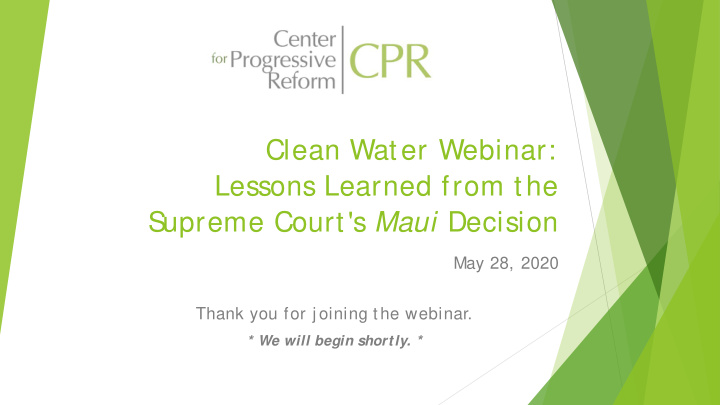



Clean Water Webinar: Lessons Learned from the S upreme Court's Maui Decision May 28, 2020 Thank you for j oining the webinar. * We will begin shortly. *
Housekeeping If you have problems with the webinar audio, you can j oin by phone at 1-646-558-8656; Webinar ID: 956 4979 3075 All participants will be muted during the webinar. If you have questions during the presentation, please type them into the Q&A box located at the bottom of your screen. Y our questions will be visible to the moderator and presenters only. The webinar is being recorded and will be shared shortly after the event. Members of the press may be j oining today’s webinar.
What is CPR? Vision: CPR is a “ t hink-and-do t ank" helping t o build t hriving communit ies on a resilient planet . Mission: CPR pursues a st rat egic agenda t hat emphasizes educat ion, advocacy, and communit y collaborat ion. CPR operat es wit h a net work of 60+ Member S cholars who are leaders in various legal academic fields, and a professional st aff of policy analyst s, communicat ion expert s, and ot hers. We work t oget her on a variet y of programs— nat ional and regional— all dedicat ed t o t he idea t hat government safeguards and ot her regulat ions are a key t o social j ust ice and planet ary healt h.
Presenters Hannah Bernard, David Henkin, Co-Founder and S taff Attorney, Executive Director, Earthj ustice Hawaii Wildlife Fund Steph Tai, Amanda Leiter, Professor, Professor, Univ. of Wisconsin Law American Univ. Washington S chool College of Law Rob Verchick, Professor, Loyola University – New Orleans S chool of Law
Melissa Lyt t le for Eart hj ust ice
Reef at Hā‘enanui (Kahekili Beach Park) with (top) and without (bottom) inj ected wastewater Images courtesy of Jen S mith
Locations of Lahaina inj ection wells and submarine springs at Hā‘ enanui Fackrell, et al. 2016
Conceptual design of Lahaina facility Glenn, et al. 2013
Glenn, et al. 2013
Tracer Dye Entering Reef at Hā‘enanui Video courtesy of Meghan Dailer
“ Functional Equivalent of Direct Discharge” Transit Time Distance Traveled Nature of Material Through Which Pollutant Travels Extent to Which Pollutant = Diluted/ Chemically Changes Percent of Pollutant Reaching Navigable Waters Manner By Or Area In Which Pollutant Enters Navigable Waters Degree to Which Pollution Maintains Its S pecific Identity
Cross section of an aquifer system with both unconfined and confined units S ource: Charles J. Taylor & William M. Alley, Ground-Wat er- Level Monit oring and t he Import ance of Long-Term Wat er-Level Dat a 4 fig.A– 2 (U.S . Geological S urvey Circular 1217, 2001).
Cross section of an aquifer system with both unconfined and perched units S ource: Daniel T . S nyder, Est imat ed Dept h t o Ground Wat er and Configurat ion of t he Wat er Table in t he Port land, Oregon Area 4 fig.2 (U.S . Geological S urvey S ci. Invest igat ions Report 2008– 5059, 2008).
Questions? Please type your questions in the Q&A box.
Thank you for joining us! Upcoming CPR webinar: Healthy soils and j ust transition, June 3, 6-7:30pm ET Please complete the survey on your screen after exiting! For more from CPR, visit at progressivereform.org or follow us at @ CPRBlog.
Recommend
More recommend